Stonemarket 2007
There are few sounds more capable of lifting the gloom of a British winter's day than that of the new Stonemarket catalogue being squeezed through the letterbox and hitting the doormat. It is, without fail, one of the few bright spots of an otherwise dismal and dreary time of year, guaranteed to be packed jam full of stunning photographs featuring genuine quality products in thought-provoking and eminently stylish arrangements.
To be honest, the felicitous event took place over a month ago, but other events have commanded my time, and although I've had the pleasure of browsing the catalogue over these uncomfortable weeks, this is the first chance I've had to commit my thoughts to what passes for paper in this cyber-existence.
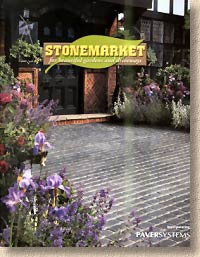
The first thing you notice about the 2007 edition is that it's much bigger than previously. Stonemarket have always opted for a non-standard size brochure; usually something bigger than A5 but not as big as A4. The new version maintains that quirkiness: it's almost as tall as A4 but is noticeably wider, and, as has also become a Stonemarket tradition, it features a stunning photo on the front cover. And at bang-on 100 pages, it's matured into a weighty tome that has no equal in the wet-cast/patio sector of the market.
Two things have propelled Stonemarket to the enviable position of being able to publish such a lavish brochure: quality of products and a willingness to innovate. The Stonemarket wet-cast products achieved their reputation by being able to hold their own against the very best of the other wet-cast products on the market and by being a damned sight better than most. However, the continual drive for innovative, distinctive products made them a massive favourite with stockists and suppliers the length and breadth of the land.
Concrete products
This ethos was carried over into their imported stone products as they re-positioned themselves in the face of the Asian onslaught, and this has taken another step forward with their commitment to the Ethical Trade Initiative, which seeks to ensure that their Indian imports are not the product of child labour. The acquisition of Scotland's Paver Systems and their block paving manufacturing capacity has created a brand that is fully rounded and able to offer a more-or-less replete palette of paving materials to designers, contractors and DIYers alike. So: what's new for 2007? Well, along with certain other wet-cast manufacturers, they've plumped for the term “handmade reconstituted stone” when what they really mean is “concrete”. I'm always wary of marketing-speak – a product should be good enough to sell itself without having to be couched in bombastic bollocks – and the Stonemarket products are good enough. I know it's been a rough few years for concrete patio flags, but pretentiously renaming them as “handmade reconstituted stone” is sleight of hand. There's nowt wrong with concrete. It's a superb material that has revolutionised the construction industry. Say it loud: I'm concrete and I'm proud!
Anyway; enough of my personal bugbears and on to the products. There's the Millstone ® Radius Star Mosaic, which, if memory serves me correctly, we saw at Glee back at the end of Summer . It's a nice enough feature, but it's the jointing that will make or break it. The accompanying photo that takes up all of page 12 is very clever in that you can't make out very much of the jointing. I'd be interested to hear what the bods at Stonemarket are suggesting, and I hope it doesn't begin with a “G”!
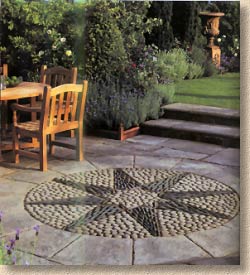
Mulberry (p22) was also on parade at Glee, and is to be supplied in a 6-size Project Pack containing 108 individual pieces that will cover just under 6 square metres when laid. I wasn't sure about this at Glee, and the photo in the brochure doesn't make me feel any more generous towards it. I'm not sure just what it is that disturbs me about this product, but, to be extremely harsh, I'd have to say it looks like a cheap riven-effect wet-cast in a strange colour. The long-thin 'uns (600x100mm) look certain to break and, judging from the photo on page 22, there's an over-reliance on using two of the same size next to each other.
The Rio Cascade curvy-wurvy paving is augmented by a single addition: the Rio Edging/Coping, which to me, looks just like a shot-textured edging that is better known by a different name. I can't get excited about it, but take a look at the photo on p36 – how gorgeous is that?
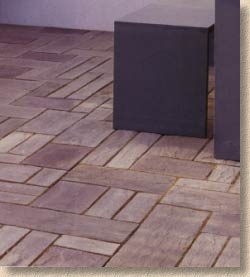
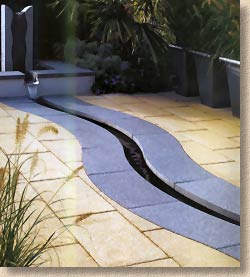
Ryton and Stretton : budget flags and hardly worthy of consideration. There are already too many budget flags on the market and while I appreciate these may be perceived as extending the Stonemarket range, they are extending it downwards. Least said; soonest mended.
Lanark walling is a budget product that is worth a mention, though, as good-looking concrete bricks for walling are not overly common in Lower Britain, where the market is awash with cheap clay products. However, Scotland and Northern Ireland, with fewer brick-quality clay reserves, have more familiarity with this type of product, and it might just attract attention from the more cost-conscious Sassenach designers. Worth checking out if you're on a tight budget.
Natural Stone
Trustone® is the Stonemarket brand for their imported natural stone paving and walling. Again, this is a sector of the market that is well-served, so unless you want to compete on price (and with some of the more suspect imports selling for under a tenner per square metre, why would you??) you have to offer quality and innovation, the two characteristics in which Stonemarket excel.
The Ethical Trade Initiative was mentioned earlier, but it's worth mentioning again because much of the really cheap imported stone is cheap because of the appalling pay and conditions endured by underage workers who ought to be slaving away in school rather than in a quarry. If you are buying imported stone this year, even if you're not choosing Trustone, please ask your supplier about where the stone is sourced. Knowing that your patio was a bargain because some poor kid in southern India was denied an education to keep your wallet stuffed leaves a nasty taste in the mouth.
Much of the Trustone range is achingly familiar, but the innovation imperative at Stonemarket doesn't allow a group of products as popular as this to stand still, so there's a whole new line, the quartzitic Fieldland™ paving, which is surprisingly York-like in texture, grain-size and colouring. This is supplemented by the dragonflies and flutterbyes that were unveiled at Glee and wowed everyone that saw them. Yes; they're a bit fiddly and they'll not suit everyone, but credit where credit's due: it's a clever idea that is bound to be developed further, and the photo of the flutterby on p47 is almost good enough to sell it to me!
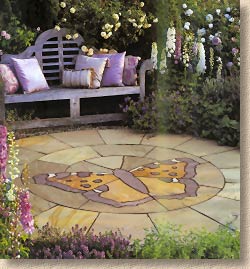
Although mentioned in the brochure, the new offering of calibrated Trustone isn't really trumpeted. Calibrated means the thickness has been regulated, so that each flag is exactly 25mm thick. This allows the laying course to be prepared by screeding, which is much, much faster than the more traditional individual bedding normally used with these imported flagstones. You pay a few bob more for the calibrating, but it can often pay for itself in the time saved in laying. Definitely worth considering if you have a larger area to cover, and I think Stonemarket should have made more noise about it in this brochure. 30 words and no pictorial explanation are hardly likely to send sales through the roof, are they?
CBPs
Running out of space, so I'll skip on to the massively expanded range of block pavers, which have come about via the acquisition of Paver Systems up in Scotland. Almost all these products are new, or new to Stonemarket, at least; Paver Systems customers will probably be familiar with many of them.
Renaissance Paviors® are the product gracing the front cover of the brochure, and they are unlike most other concrete block pavers (CBPs) on the market. Previously known as “Elegance”, the re-vamped range now offers four unfamiliar sizes and two colour options, Charcoal and Plum. This is another product that will sink or swim depending on the jointing. There's no info given in the brochure: the so-called laying guide simply refers the reader to the Stonemarket website, which is similarly light on specifics. For me, it has to be a polymeric of some sort. Perhaps the Marshall's M-Joint will be made available under a Stonemarket-ised name, or the excellent Romex Terras would be ideal, if you can get your hands on it (currently seems to be rarer than rocking horse manure).
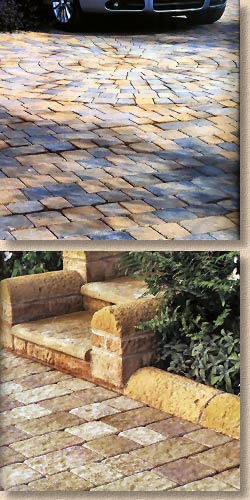
Trident® is the name given to the 3-size, 60mm tumbled block that comes in 5 colours. Not a lot to say, other than the samples I've seen of this block have an incredibly dense feel and close texture, and at a time when many manufacturers, at the behest of the Merchants, are moving to multi-size packs, it's good to see Trident comes in single size bales.
Drivestone® is a schizophrenic tumbled block. One face is your typical flat surface with distressed arisses but when you flip it over, it has a moulded, hewn-effect surface for a more rugged look. As with all of the double-faced products, there's one face that you're paying for, and the other is a relatively expensive alternative. With the Drivestone, you'd only buy it if you planned to use the more rugged face; if you wanted the smoother face, why pay the extra when you can achieve that look with the cheaper Trident? It's a handy feature when you want to provide a small amount of contrasting texture, say a flat-face edge course with the rugged face used as the main body block, but how often will that happen?
Pavilion® has become one of my favourite tumbled blocks because the six sizes enable more realistic variable width coursing or even a random layout, and the biggest block, at 300x200mm, is a distinctive feature that allows larger areas to be paved without looking too bitty. It's only available in the 50mm thickness, and all six sizes come in the one pack, but I feel this could be the one CBP in the Stonemarket range that really does take off. I'd like to see a wider choice of colours, and a 60mm thickness would be more to my liking, but I look forward to seeing more and more of this on the nation's driveways.
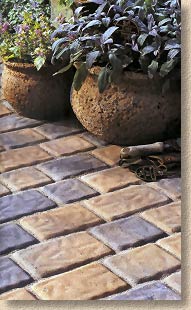
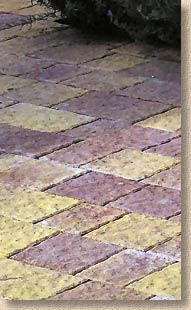
Pennon Paviors® – a moulded riven-effect block with over-emphasised arisses that comes in a 4-size project pack in a choice of 4 colours. The best thing to say about it is that it comes in a standard 60mm thickness, but as with most of these riven-effect blocks, they are not the most comfortable to walk across and they produce a distinctive rumble when driven over, which may or may not be to your liking.
Rivenstone Paviors® are another riven-effect block, but with more reasonable arisses, much like the rugged option of the Drivestone described above. It's a 3-size mix, in a single pack, with 3 colour options. I prefer this to the Pennon, but my big concern with all of these riven-effect and textured blocks is that the surface always seems to be excessively attractive to algae, whjich means you either allow it to turn mouldy greeny-black, you power-wash it at least once a year, or you use a good quality sealant to keep it in peak condition.
And to round off the range, there's a standard “ Pavedrive® ” 200x100 range, that comes in the usual five mono-colours and two multis (Brindle/red-multi and Burnt Ochre/Brown multi). However, this ever-popular format is augmented by having 200x200 and 100x100 blocks, Bishop's Hat starter units and a 200x100 format available in both 60mm and 80mm thicknesses, making it a highly versatile system at a very sensible price. As with the Trident, the face is wonderfully close-textured and they are a delight to cut in the splitter. Chuck in the adaptable Pavedrive kerb and you have everything you need for straightforward, no-nonsense block paving.
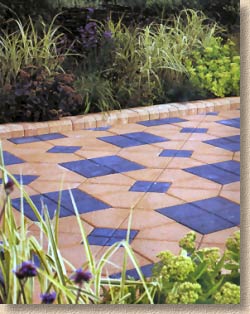
Previous incarnations of the Stonemarket catalogue have always featured a comprehensive design guide. At first, the eight pages given over to layouts and pattern in this edition seems 'light', nut I think that's a consequence of the larger page size. There's nowt missing: all the essential plans are included and there are some useful tips, especially for random layouts. The same cannot be said for the Planning and Laying Guide, which is much reduced, barely covering the last two pages. This is not necessarily a 'bad thing'. In catalogues from just a couple of years ago, Stonemarket were still promoting the despicable spot-bedding laying method, so as far as I'm concerned, I'm happier to see manufacturers stick at what they do best: manufacturing, and leave the laying advice to contractors and clowns like me. Besides, the range of products in the Stonemarket family is now so large, and the scope of installation conditions so variable, that it could take a second catalogue of similar size just to cover half of the options.
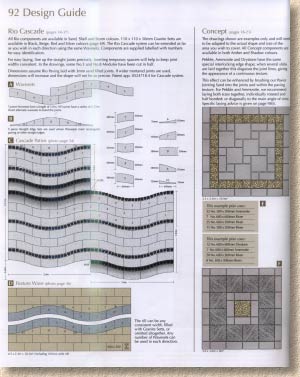
So, in summary, how does 2007's offering compare to its predecessors and its competitors? Well, as ever, the photography is probably the best in the market. The images are well considered and faultlessly executed. The larger format allows for even bigger images and there's just enough text to whet the appetite and provide the necessary information for the intended readership. I like the low-sheen paper, which again improves the images, and there's a logical progression through the various product groups. In fact, the whole thing is verging on being a coffee-table book. It has a professional look and feel, bordering on luxury, and it's almost too good to end up on the dashboard of a tranny van along with the crisp packets, coffee-stained fuel receipts, and the under-dressed page 3 girls. I know I say this almost every year, but the Stonemarket catalogue is a “must-have” if you're serious about selling paving to the driveway and patio sector. And if you're in the commercial sector, it's definitely worth taking a look at just what is possible with a little bit of thought.


